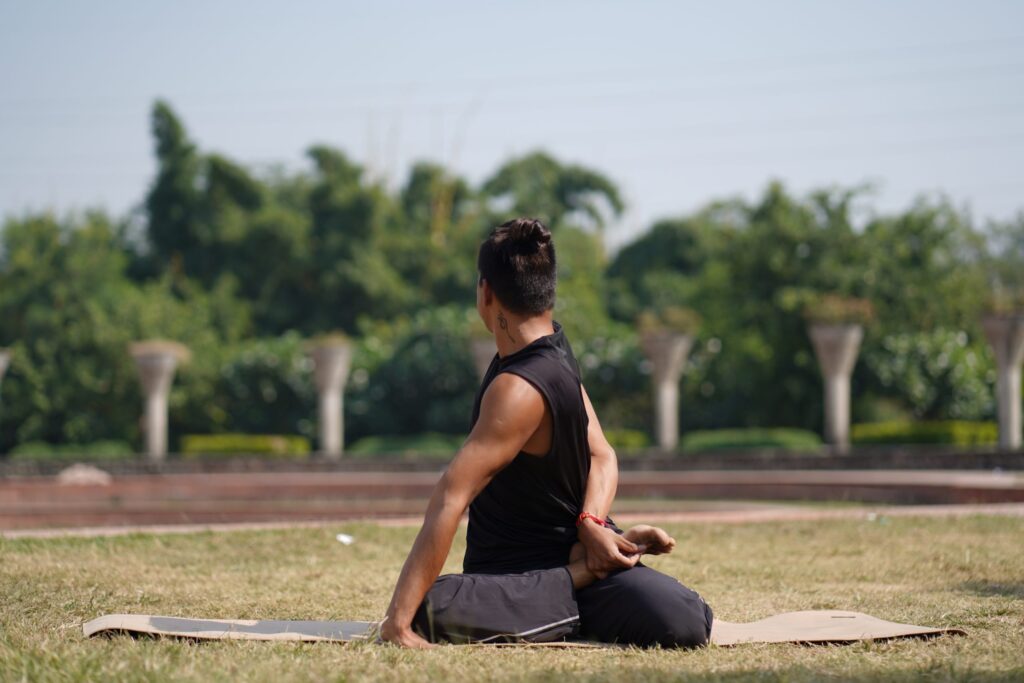Garbha Pindasana ( गर्भ पिंडासन ) is also known as Garbhasana ( गर्भासन ) which is translated in English as Foetus in Womb Pose or Embryo in Womb Pose, Foetus Pose or Embryo Pose. It is an advanced yoga posture that improves the flexibility of your knees, hips and ankles. Here, we would discuss various such benefits, steps and precautions for performing Garbha Pindasana.
The Sanskrit name ‘Garbha Pindasana‘ ( गर्भ पिंडासन ) is the combination of three terms – Garbha ( गर्भ ) meaning ‘Womb’, Pinda ( पिंड ) means ‘Embryo’ or ‘Fetus‘ and Asana ( आसन ) means ‘seat‘ or ‘pose’. In this asana, a yogi need to sit in Padmasana followed by raising of knees towards the body. Meanwhile the arms remain tucked within thighs and calves with bent elbows.
Garbha Pindasana is a Hatha yoga posture that is mentioned in medieval texts – Gheranda Samhita and Bahr al–Hayat (a Persian translated text). This pose mimics as a fetus or embryo in the mother’s womb.
Garbhasana or Embryo in the Womb Pose is believed that its practice during the 1st trimester of the pregnancy helps to assist and prepare the fetus of the pregnant woman for correct placing at the time of Childbirth.
How to practice Garbha Pindasana or Garbhasana
Following are the Step – by – Step instructions that would assist you in your practice of Garbha Pindasana ( Embryo in Womb Pose )
Step 1 :
- Sit in Padmasana (Lotus Posture) and let down your butts, raising both knees up near the shoulders.
Step 2 :
- Tilt your body back slightly and shift your entire bodyweight on your buttocks instead of your hands.
Step 3 :
- Now, insert both arms between the thigh & calf of each leg and bend your elbows under the calves.
Step 4 :
- Bring your hands and head together and hold ears with the hands or duck the head into your hands.
Step 5 :
- Breathe normally & hold the posture, either with closed eyes or your gaze fixed at any point forward.
Step 6 :
- Inhale & roll back on your spine to the right side. Swivel the buttocks clockwise to complete a circle.
Step 7 :
- Now, assume Padmasana by crossing the legs on the alternate sides and repeat all the above steps.
Step 8 :
- To release the pose, take off the hands from ears, lower your legs and untie your arms from the legs.
Precautions and Contraindications
- Avoid the practice of Garbha Pindasana, if you have any injury or ailments in your knees, hips or spinal problems.
- Avoid the practice of the asana, if you are suffering from pain in your lower back, spine, neck shoulder ankles etc.
- Women are advised to avoid the practice of this asana during their pregnancy and during their menstrual cycle.
- Avoid the pose if you’re suffering from sciatica, cervical, slip disc or have been through recent abdominal surgery
Modifications and Variations
Uttana kurmasana ( Inverted Tortoise Pose ) and Baddha Padmasana ( Bound Lotus Pose ) are the variations of Garbha Pindasana.
To deepen your experience during Garbha Pindasana, try out these following modifications and find a variation that works for you :
- If you’re unable to to hold your crossed ankles in this pose, you may use a yoga strap to bind them together.
- You may hold the upper arms below the armpits on the opposite side or your palms clasped around the neck.
- If you face difficulty to touch your ears with your fingers, then you may also keep your palms in Anjali Mudra.
Top 7 Benefits of Garbha Pindasansa
Following are the health benefits of Garbha Pindasansa – Embryo in Womb Pose that you would attain with its regular practice :
This asana helps to improve digestion, flexibility, self awareness, sub–consciousness, blood circulation and relieves body pain.
1. Garbha Pindasana Helps to Burns Body Fat
- According to a study the practice of Garbhasana causes contractions of the abdominal muscles that helps to reduce obesity
- Plus, this Embryo Pose has immense effect in reducing excess fat from your lower body especially Thighs and Hips’ muscles.
Also Read :
2. Garbha Pindasana Enhances Your Strength
- Embryo in the womb pose provides great stretching that help to strengthen the spine, abdomen, thighs, hips and lower back.
- This pose exerts pressure that increase elasticity and endurance of muscles. Plus it also remove your neck and shoulder pain.
Also Read :
3. Garbha Pindasana Activates Manipura Chakra
- During your practice of Embryo Pose, the heels get squeezed towards your navel region that stimulates the Manipura Chakra.
- This Solar Plexus chakra is often associated with improved emotional stability, spiritual awareness and control energy balance.
Also Read :
4. Garbha Pindasana Maintains Mental Health
- This asana activates your parasympathetic nervous system and offers a great relief from anxiety, anger, stress and depression.
- It not only drives out the negative thoughts and nervous disorders but also relieves psychosomatic diseases like hypertension.
Also Read :
5. Garbha Pindasana Improves Your Digestion
- The regular practice of Garbha Pindasana tones & massages your abdominal organs, consequently it increases your appetite.
- In addition, it also stimulates the secretion of digestive juices that treats gastrointestinal ailments like – constipation, gas, etc.
Also Read :
6. Garbha Pindasana Stimulates Internal Organs
- Embryo in the womb pose is beneficial for improving the functioning of internal organs like liver, kidneys, pancreas & spleen.
- Moreover, it also offers massaging effects on the muscles, maintains the hormonal balance & aids the detoxification process.
Also Read :
7. Garbha Pindasana Improves Blood Circulation
- Embryo in the Womb Pose assists to increase the blood flow throughout your body which helps to treat many skin problems.
- During the pose, arms gets squeezed through calf and thighs that apply pressure on lymphatic vessels and help to cleanse it.
Also Read :
Preparatory Poses
- Marichyasana
- Parsvakonasana
- Virbhadrasana II
- Navasana
- Vajrasana
- Padmasana,
- Kukkutasana,
- Janu Sirsasana
- Tolangulasana
- Ardha Baddha Pachimottanasana
Follow-up poses
- Bhujangasana
- Makarasana
- Matsyasana
- Chakrasana
- Trikonasana
- Shavasana
- Ashtanga Namaskar
Tips For Beginners
- Always do some warm up exercises before you start practicing this yoga posture.
- You must practice Embryo pose, under the supervision of a trained yoga teacher.
- Beginners should retain the pose for 30-60 seconds to get better health benefits.
Conclusion
Garbha Pindasana offers numerous health benefits – develops sense of balance, coordinated breathing movements, stimulates parasympathetic nervous system, prevents health diseases and improves physical awareness.
We really hope that this article would be useful guide for your practice of Garbha Pindasansa. Thus, at this fag end, we’d like to invite you to please do share your views and suggestions on this post in the comment section down below.
Also Read :
FAQs related to Garbha Pindasana and its benefits
How can Garbha Pindasana improve the functioning of internal organs ?
Garbha Pindasana is a Challenging yoga pose that looks like an unborn offspring. During its practice the stomach, lungs and other internal organs get compressed. This position works to open your hips, strengthen uterus and rectum. It also cures stomach-related diseases, relieves abdominal cramps etc.
Do Garbha Pindasana really assist to strengthen body muscles ?
Regular practice of Garbha Pindasana benefits by improving the flexibility of your knees, shoulders, arms, torso, legs ankles, hips and gluteal muscles. As this seated balancing pose involves complex bending thus it also makes your muscles toned and stronger.
How can the practice of Garbha Pindasana improve mental health ?
Garbha Pindasana is a part of Ashtanga yoga that has the regulating effect on the adrenal glands. This pose activates your parasympathetic nervous system and provides a great relief from anxiety, anger, stress and depression. Plus, it treats instability body and mind, improves your concentration.




